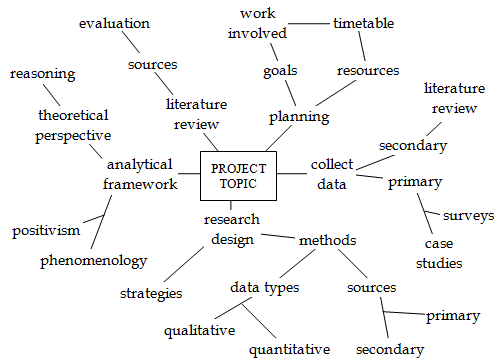Approaches to note taking:
Whichever approach you adopt, there are a number of key elements to note taking. You need to:
¨ pick out key points - the author's main ideas and important details;
¨ structure your notes to reflect the arguments and themes of the material;
¨ use your own words;
¨ jot down occasional key quotes for potential use at a later stage;
¨ ensure that the notes are properly referenced - see the later section on referencing.
Try, also, to make your notes clear and legible, and leave space for adding additional material - either from further reading or from your own reflection. Linear notes is the approach you are probably most familiar with. It comprises listing points, often numbered, and structuring them under headings to show their interrelationships.

An alternative approach is the use of mind maps (see figure 1 for an example), developed by Tony Buzan (1993, The Mind Map Book: Radiant Thinking, BBC Books). This process is based on the idea that the mind does not work in a linear way, but often branches off at a tangent, developing new trains of thought and making different connections between things. The mind map reflects this approach.
The starting point is the central theme or problem with which you are concerned in your reading. This is entered at the centre of the map. Main ideas are then written as branches from the central subject, with other ideas branching out from those, just as twigs grow on the branches of trees. It is important to condense the notes to just key words or very short phrases - not sentences. (You can, though, use the edge of the map to record quotes and longer items.)
Mind maps are a particularly effective method of organising your learning and showing relationships in a graphical manner. Using them to take notes requires some practice, but can be very rewarding. You should also find them helpful in planning and structuring the writing up of the literature review.